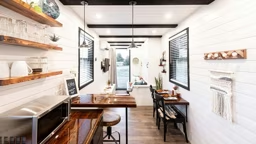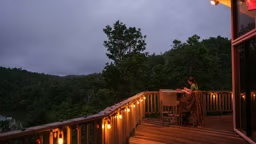
Owning a second home means paying additional utility bills. But there are big ways to make your cabin energy efficient and save some dollars. Just by adding insulation, replacing drafty windows with new energy-efficient ones, replacing older appliances with those rated as ENERGY STAR compliant and adjusting the thermostat a few degrees, you can cut down your utility bill in no time.
Other options to consider include using solar to heat your water or switching to a tankless water heater. This system provides hot water only as needed thereby eliminating the standby energy losses associated with water heater tanks
See also Estate Planning: How to Pass Down the Family Cabin
As you contemplate these changes, there are many small steps you can take to give your vacation home a vacation from high energy bills, including:
- Install ceiling fans. Use them to supplement or as an alternative to air conditioning. Ceiling fans generally use very little electricity. Make sure your fan is blowing air downward in summer.
- Use the vacation setting or turn off the water heater when no one is staying at the cabin.
- Do not keep the old refrigerator. People often upgrade their home refrigerator and think the old one still has some life in it, so they move it to the cabin. Keeping an old, inefficient refrigerator running could cost $100 more per year in electricity than a new one would. Also think twice about keeping any fridge in a garage to store extra beer or soda. The amount of time a refrigerator and freezer run is based on the temperature difference between the inside of the refrigerator and the room it is in. The higher the temperature difference, the longer any refrigerator or freezer runs to keep stored items cool. A garage usually is not insulated to the same levels as the house, so in summer it gets much hotter. Garage temperatures can exceed temperatures outside, particularly when the garage faces south or west. ENERGY STAR’s on-line calculator can provide you with the actual amount you would save by replacing your old refrigerator, whether it is in the garage or in your kitchen. Go to energystar.gov.
- Fix leaky faucets as soon as possible. Yes, if a pipe leaks in the woods and nobody’s there to hear it, it still makes a dent in the cabin owner’s wallet. One small drip can add up to 2700 gallons in a year. If it’s hot water that’s dripping, add more dollars to the cost of the water.
- Be wary of phantom loads — the appliances that may appear off, but still are using electricity. Plug cabin electronics, such as TVs and DVD players, into power strips; turn the power strips off when you leave. Even left in standby mode, electronics consume between five and 20 watts of power.
- Cover liquids and wrap foods stored in the refrigerator. Uncovered foods release moisture and make the compressor work harder.
- Toaster ovens use up to 25 to 50 percent less energy than conventional ovens. So whenever possible, use a toaster oven for small items. You won’t heat up the cabin in the summer, and you’ll be out of the kitchen and back outside in less time.
- If your cabin has air conditioning, don’t place lamps or TVs near the thermostat. The thermostat senses heat from these appliances, which can cause the air conditioner to run longer than necessary.
- Drain a pail of water from your cabin’s water heater tank every three months or as recommended by the manufacturer, to remove sediment that prevents heat transfer, lowering the unit’s efficiency.
- Clean the coils (back) and air intake grill (below the doors) of the cabin refrigerator every season. It will run for shorter periods with clean coils.
- Keep light fixtures clean — a cleaner bulb is a brighter bulb.
See also Drainage and Erosion Problems Solved
RebatesElectric and gas utilities, manufacturers and other entities may offer rebates to consumers for the purchase of energy-efficient products and appliances. Those purchased for vacation homes usually qualify. Check the Rebate Finder under Products at the ENERGY STAR website. For example, one Midwest utility provided $2 rebates for every compact fluorescent bulb its customers bought and $100 to those who bought high-efficiency washing machines. Of course, a good salesperson will be knowledgeable about any and all rebates that apply to a particular appliance — cash back is a good selling point!










